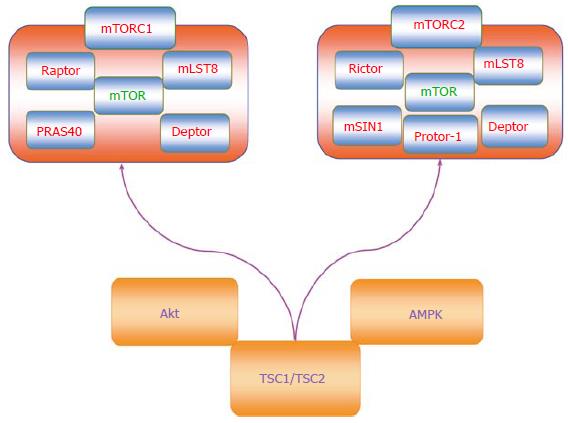Copyright
©The Author(s) 2015.
World J Stem Cells. Aug 26, 2015; 7(7): 999-1009
Published online Aug 26, 2015. doi: 10.4252/wjsc.v7.i7.999
Published online Aug 26, 2015. doi: 10.4252/wjsc.v7.i7.999
Figure 1 The components of the mechanistic target of rapamycin regulatory pathways.
The mechanistic target of rapamycin (mTOR) is an important component of mTOR Complex 1 (mTORC1) and mTOR Complex 2 (mTORC2). The function and activity of mTOR is controlled by multiple pathways that include protein kinase B (Akt), AMP activated protein kinase (AMPK), and the hamartin (tuberous sclerosis 1)/tuberin (tuberous sclerosis 2) (TSC1/TSC2) complex. mTORC1 is consists of Raptor (Regulatory-Associated Protein of mTOR), the proline rich Akt substrate 40 kDa (PRAS40), Deptor (DEP domain-containing mTOR interacting protein), and mLST8/GβL (mammalian lethal with Sec13 protein 8, termed mLST8). mTORC2 is composed of Rictor (Rapamycin-Insensitive Companion of mTOR), mLST8, Deptor, the mammalian stress-activated protein kinase interacting protein (mSIN1), and the protein observed with Rictor-1 (Protor-1).
- Citation: Maiese K. Stem cell guidance through the mechanistic target of rapamycin. World J Stem Cells 2015; 7(7): 999-1009
- URL: https://www.wjgnet.com/1948-0210/full/v7/i7/999.htm
- DOI: https://dx.doi.org/10.4252/wjsc.v7.i7.999









